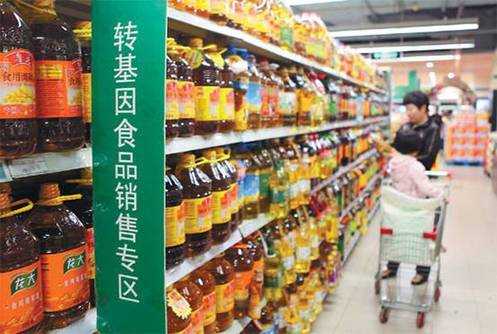轉(zhuǎn)基因技術(shù)是現(xiàn)代生物技術(shù)的核心技術(shù),自20世紀80年代以來該技術(shù)在農(nóng)業(yè)等各領(lǐng)域已得到廣泛應用。但是,迄今仍倍受關(guān)注與爭議,不少公眾擔心其潛在的風險。 12月22日,《食品安全法》(修訂草案)新增了“生產(chǎn)經(jīng)營轉(zhuǎn)基因食品應當按照規(guī)定進行標識”等內(nèi)容。

One product in China sold with genetically modified beans is oil.
[Photo provided to China Daily]
請看《中國日報》的報道
Chinese lawmakers began to consider a proposed revision to the country's Food Safety Law, including mandatory labeling of GM food.
中國立法者開始審議修訂的《食品安全法》,內(nèi)容包括強制性標識轉(zhuǎn)基因食品。
“強制性標識轉(zhuǎn)基因食品”用mandatory labeling of GM food表示。其中轉(zhuǎn)基因食品我們通常用genetically modified (GM) food 表示,genetically modified就是指“轉(zhuǎn)基因的”。轉(zhuǎn)基因(Transgenosis)作為一種新興的生物技術(shù)(biotechnology)手段,不成熟和不安性必然成為人們關(guān)注的焦點。
對轉(zhuǎn)基因的標識,此前國家已有《農(nóng)業(yè)轉(zhuǎn)基因生物安全管理條例》等規(guī)定,但這次修訂,是以法律的形式將其確定。中國是轉(zhuǎn)基因食品審批過程最嚴格的國家之一,只有7種轉(zhuǎn)基因植物(GM plants)已經(jīng)獲得安全許可(security clearance)。
目前,國際上對于轉(zhuǎn)基因標識的管理主要有:一是自愿標識(Voluntary Labeling),如美國、加拿大、阿根廷等;二是強制性標識(mandatory labeling),如歐盟、日本、韓國等。我國實行強制性標識制度。
(中國日報網(wǎng)英語點津 劉秀紅)
